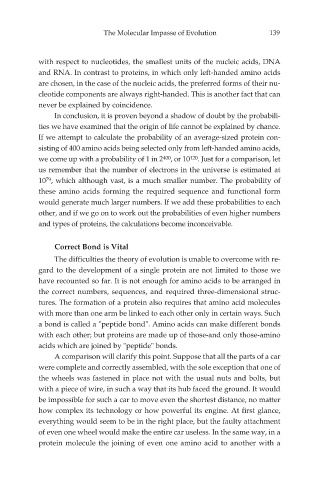Page 141 - The Evolution Deceit
P. 141
The Mo lec u lar Im passe of Ev o lu tion 139
with respect to nucleotides, the smallest units of the nucleic acids, DNA
and RNA. In contrast to proteins, in which only left-handed amino acids
are chosen, in the case of the nucleic acids, the preferred forms of their nu-
cleotide components are always right-handed. This is another fact that can
never be explained by coincidence.
In conclusion, it is proven beyond a shadow of doubt by the probabili-
ties we have examined that the origin of life cannot be explained by chance.
If we attempt to calculate the probability of an average-sized protein con-
sisting of 400 amino acids being selected only from left-handed amino acids,
we come up with a probability of 1 in 2 400 , or 10 120 . Just for a comparison, let
us remember that the number of electrons in the universe is estimated at
79
10 , which although vast, is a much smaller number. The probability of
these amino acids forming the required sequence and functional form
would generate much larger numbers. If we add these probabilities to each
other, and if we go on to work out the probabilities of even higher numbers
and types of proteins, the calculations become inconceivable.
Correct Bond is Vital
The difficulties the theory of evolution is unable to overcome with re-
gard to the development of a single protein are not limited to those we
have recounted so far. It is not enough for amino acids to be arranged in
the correct numbers, sequences, and required three-dimensional struc-
tures. The formation of a protein also requires that amino acid molecules
with more than one arm be linked to each other only in certain ways. Such
a bond is called a "peptide bond". Amino acids can make different bonds
with each other; but proteins are made up of those-and only those-amino
acids which are joined by "peptide" bonds.
A comparison will clarify this point. Suppose that all the parts of a car
were complete and correctly assembled, with the sole exception that one of
the wheels was fastened in place not with the usual nuts and bolts, but
with a piece of wire, in such a way that its hub faced the ground. It would
be impossible for such a car to move even the shortest distance, no matter
how complex its technology or how powerful its engine. At first glance,
everything would seem to be in the right place, but the faulty attachment
of even one wheel would make the entire car useless. In the same way, in a
protein molecule the joining of even one amino acid to another with a

